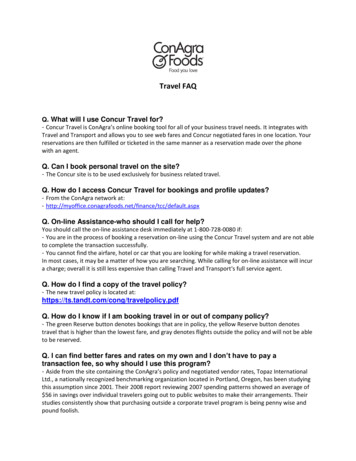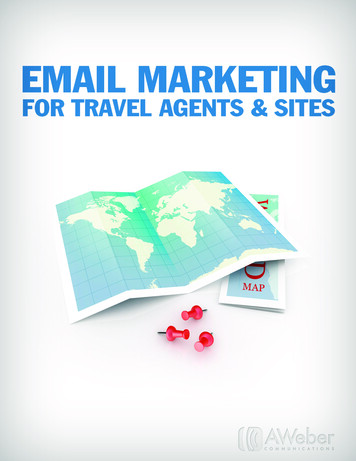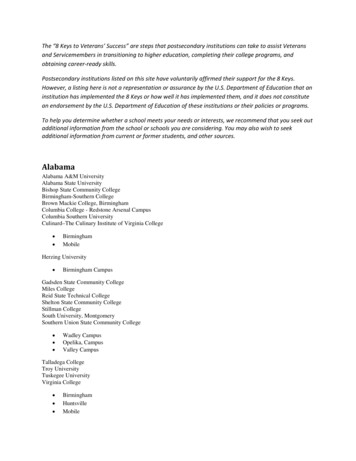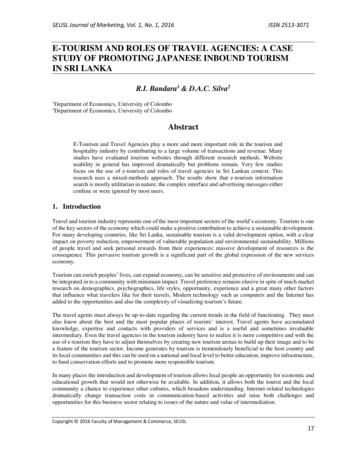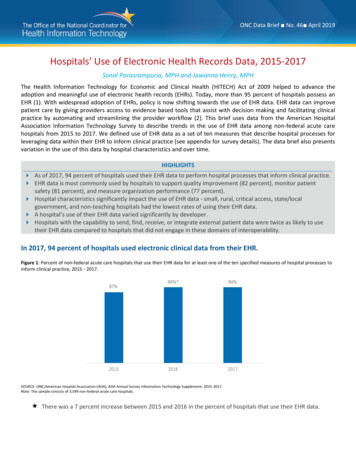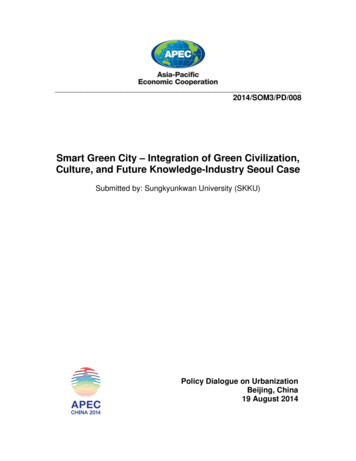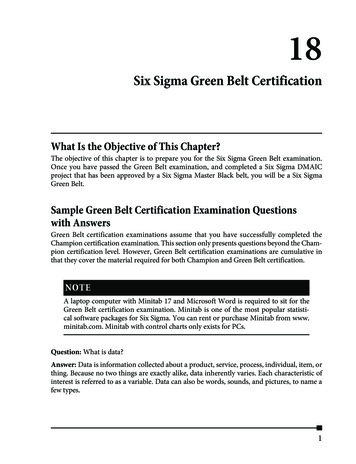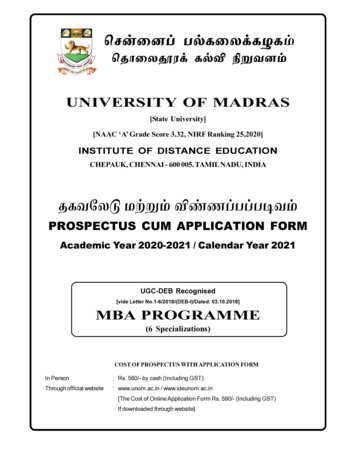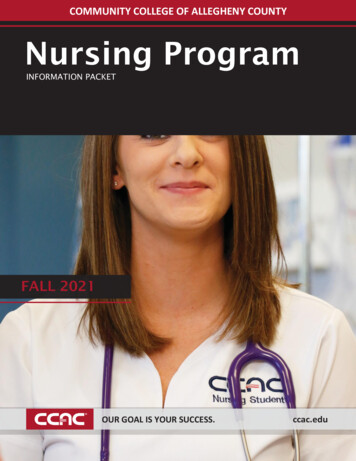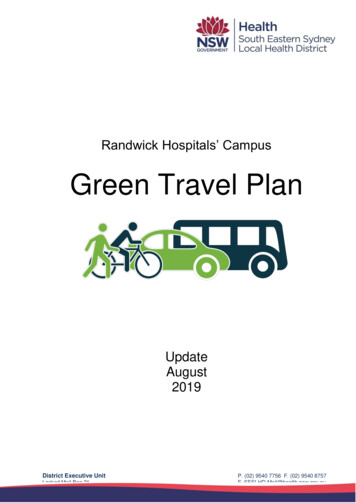
Transcription
Randwick Hospitals’ CampusGreen Travel PlanUpdateAugust2019District Executive UnitLocked Mail Bag 21TAREN POINT NSW 2229P. (02) 9540 7756 F. (02) 9540 8757E. SESLHD-Mail@health.nsw.gov.au
Randwick Hospitals’ CampusGreen Travel PlanPage 2Document VerificationJob titleJob numberRandwick Campus Redevelopment257913-00Document titleFile referenceGreen Travel PlanDocument refRevisionDateFilename20181003 Green Travel Plan Final.docxFinal3 Oct 2018DescriptionIssued for ABS Project approvalNamePrepared byChecked byApproved bySZSGAHSignatureUpdate09 July 2019Filename20190709 Green Travel Plan Update.docxDescriptionIssued for Integrated Acute Service Building (ASB) additionNameSignaturePrepared byChecked byApproved bySZSGAH
Randwick Hospitals’ CampusGreen Travel PlanThe Green Travel Plan is a partnership betweenThe partners are also working with1. Staff consultative committees2. Consumer and Community reference groups3. Local schools and surrounding community organisationsandPage 3
Randwick Hospitals’ CampusGreen Travel PlanPage 4Table of contentsDocument Verification2Executive ackgroundSite LocationWhat is a Green Travel Plan?Policy SupportEngagementExisting Travel Patterns and Infrastructure112.12.22.32.411111318Mode SplitTravel patternsPedestrian and Bicycle NetworksPublic Transport AccessibilityGreen Travel Plan 242424242526262728ObjectivesProposed Green Travel Plan MeasuresGreen Travel PlanStaff inductionCyclingWalkingCarpoolingOther measuresSummary of key monitoring mechanismsForecast Levels of Activity294.129Construction worker parking5.Mode Share Targets306.Next Steps31
Randwick Hospitals’ CampusGreen Travel PlanPage 5Executive SummarySouth East Sydney Local Health District (SESLHD) is working across the RandwickHospitals’ Campus and with a wide range of stakeholders to lead the development andimplementation of a Green Travel Plan.The Green Travel Plan sets out the:a) Future staff travel mode share targets, specifically a reduction in car driver modeshare,b) Travel demand management strategies, for visitors, patients, staff andsupplier/service personnel to encourage sustainable travel to and from theRandwick Hospitals Precinct, andc) Initiatives to implement and monitor such travel measures.A review of existing travel behaviour of staff, visitors and patients indicates that 40% ofstaff live in the Eastern Suburbs and 11% live within the suburb of Randwick itself. Justover half of those accessing the Campus use private vehicles as a primary mode oftransport, and staff public transport use is high relative to other hospitals.A number of specific measures have been outlined in this Green Travel Plan to promotethe use of public transport, walking and cycling by staff and visitors travelling to and fromthe Campus. These measures include: All new staff members are to be made aware of this Green Travel Plan as part of theirinduction process. This would involve informing staff of available sustainable transportoptions to and from the Campus; The Campus, as well as future expansion areas, are to provide new bicycle parkingand end of trip facilities for staff to further support cycling as a sustainable travelchoice. This will include secure bicycle parking, lockers, change rooms and showers;and Carpooling is to be encouraged through the implementation of a staff car sharingdatabase. This could involve establishing a staff intranet/internet page where staff canregister their interest in carpooling by indicating where they live and their shift times.The Campus may also wish to consider participating in the Hospital Carsharescheme. Public transport information will be provided to staff and wayfinding through the hospitalwill be integrated with surrounding public transport nodes. Public transport information should be provided on visitor information stands andincluded in patient admission documents.SESLHD will continue to proactively engage and consult with patients, families,community, staff and relevant government agencies to refine and implement the GreenTravel Plan initiatives.
Randwick Hospitals’ CampusGreen Travel Plan1.Page 6Introduction1.1 BackgroundThe Randwick Hospitals’ Campus is being strengthened with new investment. A newAcute Services Building for the Prince of Wales Hospital will open in 2022 and the SouthEast Sydney Light Rail will commence operation in late 2019.The South Eastern Sydney Local Health District has agreed to coordinate the developmentof a Green Travel Plan with patients, families, staff, community and government agencies.This Green Travel Plan will apply to the operation of the Integrated Acute Services Building(IASB) Addition.Key to any successful workplace travel plan is ensuring that the development process isbroadly encompassing in order to capture the views of a range of stakeholders within thehospital and across the Campus. This helps ensure that the best information isincorporated into the plan to make it more effective and viewed as an important part of theCampus operations.This version of the Green Travel Plan must be submitted as part of the statutoryrequirements for planning approval for the Integrated Acute Services Building (IASB)Addition. Extensive consultation will continue over the coming years to ensure that allstakeholders can be involved with finalising and implementing the actions.1.2 Site LocationThe Randwick Hospitals’ Campus (Campus) is located approximately 7.2km south-east ofthe Sydney CBD and forms part of the Randwick Health and Education Precinct. TheUniversity of New South Wales (UNSW) is located to the west of the Campus, whileRandwick Junction Town Centre is located immediately to the north.The current Campus is bound by High Street to the north, Avoca Street to the east, BarkerStreet to the south and Hospital Road to the west. The Campus consists of four hospitals;Prince of Wales Hospital, Sydney Children’s Hospital, Randwick, the Royal Hospital forWomen and the Prince of Wales Private Hospital as well as associated research institutes;Black Dog Institute, Neuroscience Research Australia and the Bright Alliance.As part of Stage 1 of the Randwick Campus Redevelopment, a new Acute ServicesBuilding (ASB) will bridge the physical gap between the Campus and UNSW. The ASB willinclude a new intensive care unit, operating theatres, extra beds and a new emergencydepartment. The approved ASB (SSD 9113) will enable education, training and researchto be more closely integrated into the health care services provided across the precinct.The location of the new ASB as part of the Campus is shown in Figure 1. The IASBAddition to the east of the ASB utilises the airspace over Hospital Road. Oughtthere be a short description of the purpose of the IASB Addition?
Randwick Hospitals’ CampusGreen Travel PlanFigure 1: Randwick Hospitals’ Campus and approved ASB and future expansion areaPage 7
Randwick Hospitals’ CampusGreen Travel PlanPage 81.3 What is a Green Travel Plan?A Green Travel Plan is a package of measures implemented by an employer to encouragemore sustainable travel for the journey to and from work and also during the course ofwork. It is a means for an organisation to reduce the use of cars by staff, particularlydriving to and from work and for work related travel. Through a Green Travel Plan,workplaces can also demonstrate commitment to a more proactive approach in improvingpeople’s health and wellbeing and the environmental sustainability of its activities.The principles of a Green Travel Plan are applied to all people travelling to and from a site.Government authorities are placing increasing emphasis on the need to reduce thenumber and lengths of motorised journeys and in doing so encourage greater use ofalternative means of travel with more environmentally positive outcomes.The intention of this Green Travel Plan is to:a) Set future staff travel mode share targets, specifically a reduction in car driver modeshare,b) Detail the travel demand management strategies, for visitors, patients, staff andsupplier/service personnel to encourage sustainable travel to and from theRandwick Hospitals’ Campus,c) Describe initiatives to implement and monitor such travel measures,d) Promote healthy living to staff by encouraging the integration of walking/cycling intotheir everyday routine.1.4 Policy SupportNSW Health policy is well aligned to the intent of the Green Travel Plan and increasing theuse of healthy and sustainable modes, including walking and cycling. The NSW StateHealth Plan Towards 2012, NSW Healthy Eating and Active Living Strategy 2013 – 2018and the NSW Health Hospitals Car Parking Fees Policy (2013) all provide strong supportfor the Green Travel Plan approach.The SESLHD is aligned to the purpose and intent of the Green Travel Plan. It has adoptedthe Journey to Excellence Strategy 2018 – 2021 (Strategy), following the Roadmap toExcellence 2014 -2017. It sets out the strategic priorities for the LHD in the short term,continuing a process of transformation.The Strategy looks to a broad future vision, including:“Much better links between health services and other agencies, such as education,community services, justice, transport, primary care and local councils so together, we canimprove the health and wellbeing of our communities and whole population across ourregion.”While also identifying key strategic themes that include: “Community wellbeing and health equity: we will work together with our partners toachieve health, wellbeing and equality for our shared communities.”
Randwick Hospitals’ CampusGreen Travel Plan Page 9“Workforce wellbeing: we will create an environment where our people can beaccountable, happy and well, and supported to reach their potential."In 2019, SESLHD released its Environmental Sustainability Plan 2019 – 2021 in which itsPeople and Places theme has a specific module dedicated to Travel and Logistics. Thismodule has specific objectives and targets that support and/or overlay with the GreenTravel Plan including the ongoing assessment of transport and travel, provision of facilitiesfor active travel, innovation and, importantly, communications about sustainable traveloptions to staff.The Randwick Hospitals’ Campus has committed to broader planning of the RandwickHealth and Education Precinct which includes improving the urban environment throughfour key principles:1. Supporting a green environment,2. Connecting open spaces, buildings and key centres of activity,3. Integrating quality and diverse spaces that encourage people to gather to meet,relax and foster collaboration, and4. Being responsive to the natural environment and respectful of the area’s heritageand long history.The Randwick Campus Redevelopment, which will deliver the new Acute ServicesBuilding, identifies the need for putting patients first, which includes addressing accessissues in and outside of the hospital.The six design principles are: Patients first People collocated and collaborative Services integrated and not duplicated Evidence-based and/or evidence generating Flexible and future ready Support patient care beyond the boundaries of the hospital1.5 EngagementHealth Infrastructure’s guiding principles for capital projects in relation to communicationsand engagement are being used across the Campus. These are: Proactive stakeholder engagement Proactive and transparent communications Coordinated information CollaborationThe first public material focused on transport, access and car parking and was developedand presented to staff and community in April 2018. A Staff Travel Census wasundertaken in June 2019 and data has been used to update base line travel data in thisupdate of the GTP.
Randwick Hospitals’ CampusGreen Travel PlanPage 10A GTP operational user and advisory group consisting of diverse stakeholders across theHospitals Campus was established in May 2019. The group meets monthly to guide theimplementation of the plan.A separate project user group consisting of relevant Hospital Campus stakeholders isalso meeting monthly with experts and architects to drive forward the development of thenew end-of-facility due for opening 2020.Briefings to staff and stakeholders in regard to the baseline staff travel census and GreenTravel Plan have been received well and provide a strong platform for ongoingengagement and implementation of the GTP.Regular engagement and consultation will continue as certain actions are furtherdeveloped and implemented which will include: Engaging with all of the community and consumer reference groups across theCampus Establishing an online forum to collect staff and visitor feedback which will be used toupdate the GTP initiatives Establishing user groups on cycling and other issues from time to time as needed Undertaking regular staff updatesSESLHD will also work collaboratively with other key stakeholders such as UNSW,Randwick City Council, Transport for New South Wales and community groups.This Green Travel Plan will be updated and amended as the implementation progresses.
Randwick Hospitals’ CampusGreen Travel Plan2.Page 11Existing Travel Patterns and Infrastructure2.1 Mode SplitThe most notable features of the existing hospital campus staff travel patterns are: 39% of staff live within the Eastern Suburbs (within 5 km of the Campus); and of the total staff population, 11% live in Randwick.The high proportion of staff living in close proximity to the Campus provides greatopportunities for travel via non-car modes of transport – such as public transport, walkingand cycling.2.2 Travel patternsA Travel Census was undertaken in late June 2019. The data from this survey hasbeen used to inform and update the travel behavior and mode share within thisupdated GTP, Key insights from these were: Just over half of staff drive to work (55%) and 4% travel as a car passenger. Publictransport accounts for 25% of the mode share, while 11% access the Campus viawalking (see Figure 2); and The majority of visitors and outpatients access the Campus via private vehicle, andapproximately 17% utilised public transport (see Figure 3).The 2019 Travel Census provides a baseline for the GTP.
Randwick Hospitals’ CampusGreen Travel PlanPage 12Figure 2: Staff mode share (RHC Staff Travel Census, 2019)Figure 3: Visitor mode shares (RHC Staff Travel Census, 2019)To have a clear understanding of the current travel behaviours, it is important to comparethe results of the 2012 staff survey with the latest (2016) Census data. This comparisonis shown in Table 1.Table 1: Mode share comparison between the 2019 Travel Census and 2016 Census dataProportion of Total TripsMode of TravelCar Driver2019 RHC TravelCensus55%2016 CensusJTW56%Car Passenger4%5%Public Transport25%21%Walk11%14%Other (including Cycling)3%4%100%100%TotalThe Travel Census data is highly consistent with the 2016 Census Journey to Work data.
Randwick Hospitals’ CampusGreen Travel PlanPage 132.3 Pedestrian and Bicycle NetworksThe existing bicycle network surrounding the Campus is shown in Figure 4. The roadshoulder on Doncaster Avenue and Houston Road provides a north-south bicycle routethat connects Kingsford and Kensington to the Anzac Parade bicycle route at CentennialPark, continuing on to the Sydney CBD. A shared path (shared by pedestrians andcyclists) on Alison Road and Wansey Road provides a connection between the Campus,Randwick Racecourse and Centennial Park. A shared path is being provided along BotanyStreet adjacent to the ASB as a condition of the ASB planning consent.Figure 4: Existing bicycle network serving the Campus (Randwick City Council, 2018)
Randwick Hospitals’ CampusGreen Travel PlanPage 145, 10, 15 and 20 minute walking and cycling isochrones for the Randwick Campus areshown in Figure 5 and Figure 6, respectively. Key desire lines around the Campus forwalking and cycling are accentuated by Strava (a popular website/mobile application usedto track walking, running and cycling activity) outputs shown in Figure 7.Figure 5: Walking isochrones to/from Randwick Campus
Randwick Hospitals’ CampusGreen Travel PlanFigure 6: Cycling isochrones to/from Randwick CampusPage 15
Randwick Hospitals’ CampusGreen Travel PlanPage 16Figure 7: Heat map showing key pedestrian and cyclist routes and intensity of use (Strava, 2018)Randwick City Council has developed a network of priority bike routes that will beimplemented as part of Randwick’s 20-year City Plan. The eleven routes include seveneast-west links that help to improve access towards the coast and west towards GreenSquare, and four north-south routes that allow cyclists to travel safely towards the city.Figure 8 shows the new separated cycleway connections proposed as part of the CityPlan.
Randwick Hospitals’ CampusGreen Travel PlanProposed ASBFigure 8: Proposed cycle network (Randwick City Council, 2017)Page 17
Randwick Hospitals’ CampusGreen Travel PlanPage 182.4 Public Transport AccessibilityBus accessibilityThe southern end of Belmore Road, which is located at the north-eastern boundary of theRandwick Campus, is a district hub for buses in Sydney’s Eastern Suburbs. Figure 9below shows the bus stops in the vicinity of the Campus.Figure 9: Bus stops in the vicinity of the Campus (Basemap source: Google, accessed July 2018)A number of bus routes, shown in Figure 10, frequent these stops, including: All-day services connecting the south-eastern suburbs with Central Station and theSydney CBD via Moore Park – routes 372, 373, 374, 376, 377 and M50;A range of express service variants of these routes that operate during peak hours;North-south services that connect centres in the Eastern Suburbs, including BondiJunction and Maroubra Junction – routes 314, 316, 317;East-west services that connect Randwick with Bondi Junction, Green Square, Mascotand various locations in the inner western and southern suburbs – routes 348, 400, 410and 418;Leichhardt to Coogee – route 370; andCentral Station - UNSW express bus services – routes 891, 893 and 898.Most bus services travel along Belmore Road, with some using High Street, Alison Roadand Avoca Street. Recent changes associated with the construction and operation of theCSELR have resulted in buses using Arthur Street instead of High Street.
Randwick Hospitals’ CampusGreen Travel PlanPage 19Transport for NSW (TfNSW) are currently designing a new bus network for Sydney’ssouth-east to support the introduction of the CSELR. The new bus network will continue tosupport local links to Randwick’s Health and Education precinct.Figure 10: Existing bus services and future light rail servicing the Randwick CampusA summary of the frequency of services of the bus routes mentioned above is included inTable 2.
Randwick Hospitals’ CampusGreen Travel PlanPage 20Table 2: Bus service frequencies (weekday)Bus routeBus services (per day)372 – Coogee to Central Railway Square79372 – Central Railway Square to Coogee67373 – Coogee to City Circular Quay104373 – City Circular Quay to Coogee120374 – Coogee to City Circular Quay45374 – City Circular Quay to Coogee46376 – Maroubra Beach to Central Railway Square35376 – Central Railway Square to Maroubra Beach31377 – Maroubra Beach to City Circular Quay46377 – City Circular Quay to Maroubra Beach50M50 – Coogee to Drummoyne66M50 – Drummoyne to Coogee66314 – Coogee to Bondi Junction36314 – Bondi Junction to Coogee37316 – Eastgardens to Bondi Junction22316 – Bondi Junction to Eastgardens24317 – Eastgardens to Bondi Junction24317 – Bondi Junction to Eastgardens26348 – Wolli Creek to Bondi Junction37348 – Bondi Junction to Wolli Creek37400 – Sydney Airport to Bondi Junction via Eastgardens140400 – Bondi Junction to Sydney Airport via Eastgardens139410 – Bondi Junction to Rockdale15410 – Rockdale to Bondi Junction16418 – Bondi Junction to Burwood46418 – Burwood to Bondi Junction48420 - Eastgardens to Burwood via Sydney Airport & Rockdale54420 - Burwood to Eastgardens via Rockdale & Sydney Airport54370 – Leichhardt Marketplace to Coogee71370 – Coogee to Leichhardt Marketplace68X73 – City to Coogee15X73 – Coogee to City24X74 – City to Coogee7X74 – Coogee to City14891 – Central Station to UNSW139893 – UNSW to Central Station107898 – UNSW to Central Station49
Randwick Hospitals’ CampusGreen Travel PlanPage 21CBD and South East Light RailThe CBD and South East Light Rail (CSELR) is a new light rail network for Sydney. It iscurrently under construction and the first services are anticipated to begin in late 2019.The 12km route will feature 19 stops, extending from Circular Quay along George Street toCentral Station, through Surry Hills to Moore Park, then to Kensington and Kingsford viaAnzac Parade and Randwick via Alison Road and High Street. The proposed light railalignment and stops are shown in Figure 11.The eastern end of High Street, which forms the northern boundary of the RandwickCampus, will feature a terminus for the CSELR. Light rail services will terminate at a stopon High Street immediately west of the Belmore Road and Avoca Street intersection.Light rail services will travel from High Street towards the Sydney CBD every eight minutesbetween 7am and 7pm on weekdays, when the CSELR commences operation. There willbe a number of bus operational changes associated with the introduction of light railincluding amendments city-bound bus services, potentially changing the number of busservices using Belmore Road, particularly at peak times.
Randwick Hospitals’ CampusGreen Travel PlanPage 22UNSW HighStreet andRandwick LRstops provideexcellent accessFigure 11: Proposed CSELR rail route alignment (TfNSW, 2017)A review of the CSELR Environmental Impact Statement (EIS – TfNSW, 2013) shows theforecast line loading for the light rail at 2021. The CBD bound and Randwick bound lineloading for the 2021 AM peak scenario is shown in Figure 12 and Figure 13, respectively.While the majority of light rail passenger trips will be CBD bound in the AM peak, abalance of contraflow movements is anticipated given the demand generated by UNSWand the Randwick Hospitals’ Campus. AM peak line loading of approximately 80% isforecast for Randwick bound services, with the majority of passengers alighting at theUNSW High Street stop. This indicates that there is sufficient forecast capacity to meetadditional demand resulting from increased patronage by hospital staff and visitors.
Randwick Hospitals’ CampusGreen Travel PlanPage 23Figure 12: CSELR line load and capacity consumed - 2021 CBD bound AM peak (TfNSW, 2013)Figure 13: CSELR line load and capacity consumed - 2021 Randwick bound AM peak (TfNSW,2013)
Randwick Hospitals’ CampusGreen Travel Plan3.Page 24Green Travel Plan Framework3.1 ObjectivesThe main objectives of the Green Travel Plan are to reduce car driver mode share andencourage the use of more sustainable means of transport.The more specific objectives include: Meet the targets to increase mode share for public transport, cycling and walkingto/from work journeys; Provide adequate facilities at the Campus to support staff and visitors to commute bysustainable transport modes; Reduce substantially the number of car journeys to and from the Campus; Promote the health benefits of active (i.e. Walking/Cycling) transport; Encourage new employees to use sustainable transport; and Raise awareness of sustainable transport amongst staff and visitors.3.2 Proposed Green Travel Plan Measures3.2.1Green Travel PlanDescription of measureThe green travel plan will be implemented to promote the uptake of public transport,walking and cycling by staff and visitors for travel to and from the Campus and discouragethe use of private vehicles where possible.Monitoring mechanisms Annual travel survey of staff and visitors to be conducted to understand travel patternsand trends of people travelling to and from the Campus. The baseline Travel Census inJune 2019 is the first of the annual program. Car parking data and observations of cycle parking use around the campus.3.2.2Staff inductionDescription of measureTo ensure new members of staff are aware of the Green Travel Plan, all new staffmembers will be made aware of the Plan as part of their induction process, which willinclude: A brief introduction to the plan and its purpose; Map of the Campus showing public transport stops, bicycle parking areas, lockers, andshower and changing facilities;
Randwick Hospitals’ CampusGreen Travel PlanPage 25 Staff access to a designated end of trip facility (based on the specific working location);and Provision of transport information packs or personalised journey planning services tonew staff explaining the various ways (other than motor vehicle) of travelling to andfrom the Campus.Monitoring mechanisms Annual travel survey of staff and visitors to be conducted to understand travel patternsand trends of people travelling to and from the Campus, and South Eastern Sydney Local Health District (SESLHD) to maintain a record of thenumber of staff inducted through the updated process.3.2.3CyclingDescription of measureBased on the 2019 RHC Staff Travel Census, the top 5 barriers to the use of bicycles as amode of transport to work include: Lack of bike racks / secure parking Lack of showers and change rooms Lack of local infrastructure: lanes / paths / routes Weather difficulties Navigating traffic and busy roads (rider confidence)To support cycling as an option for staff traveling to and from work, bicycle parking andend of trip facilities (showers, change facilities and lockers) for staff will be identified andaugmented as necessary.The project is currently exploring opportunities during detailed design for the constructionof appropriately sized and specified end of trip facilities in close proximity to the AcuteServices Building, within the existing hospital car park. The end of trip facilities will besized and specified to meet needs and encourage a greater take up of cycling. All staff willbe made aware of the bicycle parking and end of trip facilities available.Events such as National Bike Week and Ride2Work Day, which encourage the usageof bikes as a mode of transport, should also be promoted. Events can also be timed topromote the use of the local cycleway network as Council opens new connections.A bicycle user group was established by SESLHD in June 2018. This group will be animportant stakeholder in defining future cycle user provision across the Campus. It isrecommended that this user group will be a partner in implementation of initiatives throughthe GTP governance structure. The group has already facilitated the undertaking of adetailed user survey of bicycle end-of-trip facilities in April/May 2019. Investigate potential additional barriers to those identified above that may be deterringstaff from cycling to work through a survey; Initiate and promote a Buddy Cycling initiative (the pairing of an experienced rider witha new/less-confident rider to help familiarise them with cycle routes); and
Randwick Hospitals’ CampusGreen Travel Plan Page 26Provide staff with access to custom and local area bike maps.The Campus may initiate a trial with a private bike company to provide rental bicycles tostaff. This would provide staff with an opportunity to trial cycling as a mode of travel towork, before committing financially by purchasing a bike. This external company may alsoorganise training for staff who are beginner cyclists.Monitoring mechanisms SESLHD to monitor the demand for bicycle parking at the Campus through anoccupancy survey undertaken annually; and Annual travel survey of staff and visitors to be conducted to understand travel patternsand trends of people travelling to and from the Campus.3.2.4WalkingDescription of measureGiven the large proportion of staff living nearby to the Campus, there is opportunity toincrease the proportion of people walking to work. The identification and provision of endof trip facilities is anticipated to encourage more staff to walk to the Campus. There is alsoopportunity to improve existing connections between the Campus and the wider pedestriannetwork, including: Improved signage and wayfinding The provision of custom and local area walking maps; and Improved lighting along pedestrian routes.Monitoring mechanisms SESLHD to monitor the percentage of staff walking to the Campus through travelsurvey Obtain feedback from staff regarding issues they may have walking certain routes andliaise with local authorities regarding improvements (e.g. lighting and security issues)3.2.5CarpoolingDescription of measureCurrently only a small number of staff who drive to the Campus have a passenger. TheTravel Census in June 2019 indicates just 4% of staff travel to work as a car passenger.Of these, the majority (83%) travel with a domestic partner, with little-to-no organized tripsharing. This presents an excellent opportunity to promote car-pooling as method ofcommuting to work.This would involve the implementation a staff car sharing database or matching system.This could involve a staff intranet page where staff would register their interest incarpooling by indicating where they live and their shift times.A website has recently been established (www.hospitalcarshare.com.au) which allowsstaff members at participant hospitals (Hornsby Ku-ring-gai Hospital participates) toconnect with each other to encourage sharing a lift to and/or from work. Randwick Campuscould participate in this scheme and promote the website to their staff members.
Randwick Hospitals’ CampusGreen Travel PlanPage 27Figure 14: Example hospital car share websiteThe Campus may also consider offering a subsidised parking rate or preferentialparking locations to people with two or more staff members in the car.Monitoring mechanisms Annual travel survey of staff and visitors to be conducted to understand travel patternsand trends of people travelling to and fr
Health Plan Towards 2012, NSW Healthy Eating and Active Living Strategy 2013 – 2018 and the NSW Health Hospitals Car Parking Fees Policy (2013) all provide strong support for the G
